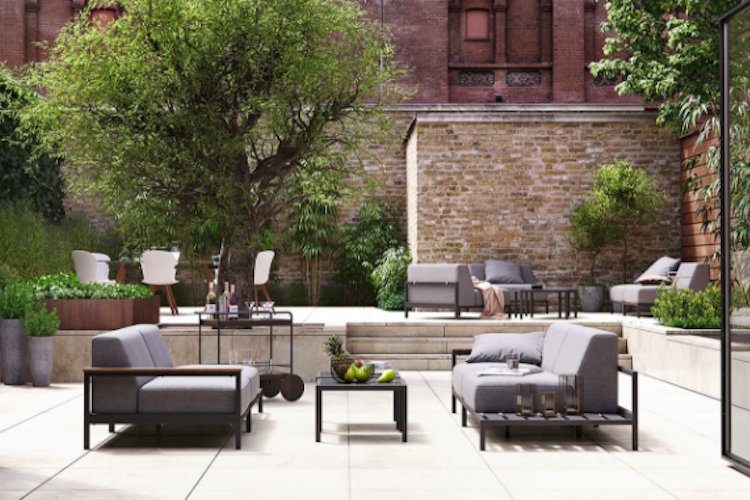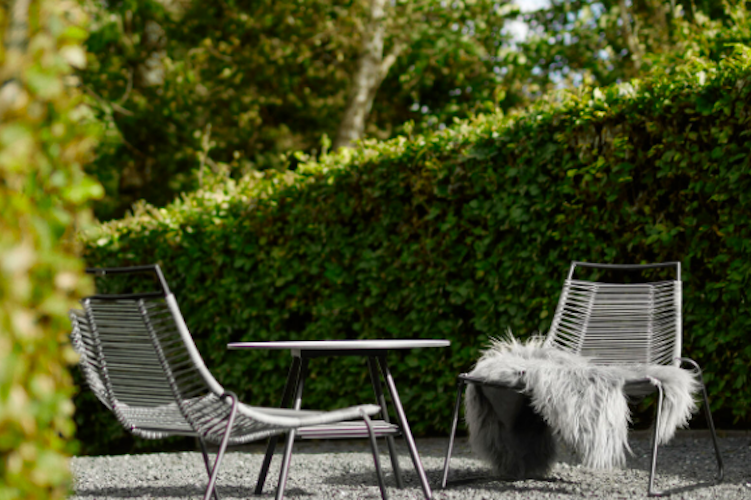Has there ever been a more important year to reinvent your outdoor space for summer? Perhaps you’re still spending more time at home due to health-related restrictions. Or maybe the warmth of the season is calling you outside. Whatever the reason, smart choices can help make sure that you are making the most of your outdoor spaces.
For advice, we turned to Kalina Todorova, Visual Merchandising Manager for BoConcept. She’s got plenty of experience shaping space. “I pretty much define the visual expression and display of anything that’s in our showrooms,” she explains. “What materials, colors, configurations? How are they displayed together with other products?”
Since Todorova’s job is “a global responsibility,” she has experience helping style spaces from tiny balconies to sprawling verandas. “We’re in a lot of big cities—Tokyo, Hong Kong, New York—where space is limited,” she says. “We also are in areas where space is not an issue, so there we can go with larger scale products.” But if you ask Todorova, the issue is less about sheer size and more about psychology.
Consider the Value of Your Outdoor Space
Contrary to what one might assume, outdoor spaces were not the first place people turned when stay-at-home orders took effect. “We were quite busy in the beginning with interior spaces,” Todorova recalls. First focuses included home offices and home gyms. “Little by little, people realized: ‘Okay, this is more of a permanent situation.’ We started seeing demand for outdoor products as well.”
Consumer priorities ranged from “creating that vacation feel” to “taking maximum advantage of the outdoor space, whether it’s a small balcony, yard, deck,” Todorova says. “Our customers realized, ‘Hey, I can turn this outdoor space into more permanent space to use—not just during the short period of summer, but maybe I can stretch it to the colder months, as well.”
“We saw outdoor space used for home offices, on occasion, when the weather was nice,” Todorova says. Then, as people began to figure out the mechanics of pandemic bubbles, they began “using it for socializing safely with your closest friends—so more seating!”
Todorova sees a positive side to being cooped up. “Time spent in our homes gave us time to reconsider, rethink and appreciate the space that we have,” she says. “We connected more with our homes.” And she thinks that connection will continue. “Of course, we will start going out. We will have more opportunities to go back to normal life. But I think the appreciation of the home—spending time at home and connecting with the outdoors, it will continue”
Reinvent Your Space by Redefining Earth Tones
One way to maximize your outdoor space is to embrace earth tones. But if the term “earth tones” makes you think of autumn leaves, think again. “There are two ways to look at earth tones. The more common description is tones that are derived from earth, meaning soil,” she says, mentioning yellows, reds and browns. “But I have also seen definitions meaning colors derived from nature,” she continues. “Then we see blues as water, greens as grass and so on.”
“Start with light, neutral tones for the larger pieces—an outdoor sofa or something upholstered,” Todorova explains. “But then you can go wild for prints and patterns on cushions and rugs or anything else,” she says. “That’s where you can bring the excitement.” Keep the color scheme consistent to evoke a certain feeling. “If you want your outdoor space to have maybe more Mediterranean feel,” she suggests, “the Mediterranean is known for the blues.”
Ultimately these colors can change the way you feel. “We all go to the same design school and that is nature,” she explains. Through our experience of nature, we make associations with colors. “If we swim in the ocean, the feeling is very cooling, so we associate blue with the feeling of cooler temperatures,” Todorova explains. Similarly, we associate yellows with the warm sun and red with the heat of fire. But it gets more complicated than that. “Interesting fact: warm colors like the red can increase your appetite,” says Todorova.
So warm colors can keep your backyard barbecues hot and hungry, while cooler colors may help subvert summer’s sizzle. But if you’re still not certain, Todorova reassures, “At BoConcept we have design consultants that can help clients make the right decision.”
Make Outdoor Space Comfortable with Curves
When it comes to furniture, trendsetters are leaning into the curves. “Organic shapes—rounded edges, softer curved furniture—are back,” says Todorova. She explains that this is an evolution that began with engineering. “With more advanced technology, it’s easier to cut complicated shapes out of materials: whether it’s ceramic—and ceramic is super popular now in surfaces—or it’s glass or it’s something else.”
As with colors, Todorova says these soft shapes can have a psychological effect. She traces their re-emergence to uncertain times about three or four years ago. “It was in a period of time when we were looking to turn our homes into our sanctuaries,” she says. “There was that need for something positive.”
The pandemic created a similar need to cocoon. “If you think about sand dunes’ flowing, curved lines. It’s very soothing,” Todorova explains. “If you think of a cliff—very stark, straight shapes—the feeling there is very different. So, if you look at a 90-degree edge on a dining table versus more of a soft curved line, subconsciously, the [latter] feeling is more inviting.”
“First, we started seeing upholstery, like sofas with organic shapes and chairs, especially dining chairs,” Todorova remembers. “They became more curved in design. And some of our most popular designs like the Adelaide chair,” she says, “with a very organic shape, became an instant success.” She also points to dining room table shapes trending from rectangular toward oval.
Todorova admits that parts of our homes, such as storage units and bookcases, usually make more sense with straight lines. Fortunately, less linear furniture can be a perfect complement. “The two work well together,” says Todorova, noting that BoConcept continues to find success with organic-shaped pieces from mirrors to chaise lounges. “We see that indoors, outdoors. It is a big trend.”
What Not to Where
When conversation comes around to mistakes people make with outdoor spaces, Todorova prefers offering recommendations rather than citations. For example, she suggests adding interest by introducing contrasts. “Contrast can be brought in many different ways. It could be contrast surfaces. It could be: we combine glass with something soft,” she says. “If we look at space and we only see the same shape—everything square—maybe it’s not the most exciting thing to look at. But once you start breaking the geometry and bringing something else, it becomes more engaging, more intriguing.”
Todorova notes that the best looking designs may still be the wrong choice, if they’re not fit for purpose. “Sometimes we may make a design choice based purely on the design of something and do not consider the material,” she says. “Being outside, it takes the beating of the weather and rain and cold,” she explains. “Make sure the materials—the quality and durability— are designed to be outdoors.”
What’s more: size matters. “It’s important to work with the right scale,” Todorova says. “If it’s a balcony that you have,” she adds, “space may be limited. Go with a smaller scale product: maybe stackable chairs, something that you can move around easily. Use the verticality of the space—maybe some shelving that you can use for plants.”
What to Remember When Reinventing Outdoor Space
Ultimately, Todorova offers plenty of practical suggestions for reinventing outdoor space. Try to keep it usable for purposes from home entertaining to working from home. Employ warm colors to add spice or cool colors for a sense of serenity. Don’t be afraid to shake up outdoor space by mixing straight and organic lines and embracing a variety of textures. And while it’s important to scale all pieces to fit your space, tend toward neutral colors for larger pieces while expressing more personality in smaller pops of color.
As for what Todorova seeks in the great outdoors? “My personal inspiration when it comes to outdoor spaces is zen in Japanese gardens,” she says. “They’re really created to appreciate the beauty of nature,” she continues. “Being in those gardens, you really get that feeling of complete relaxation.”
For more advice on designing a stunning outdoor space, be sure to check out these expert tips.
Paul Hagen is a writer and editor for aspire design and home magazine.
Like what you see? Get it first with a subscription to aspire design and home magazine.




